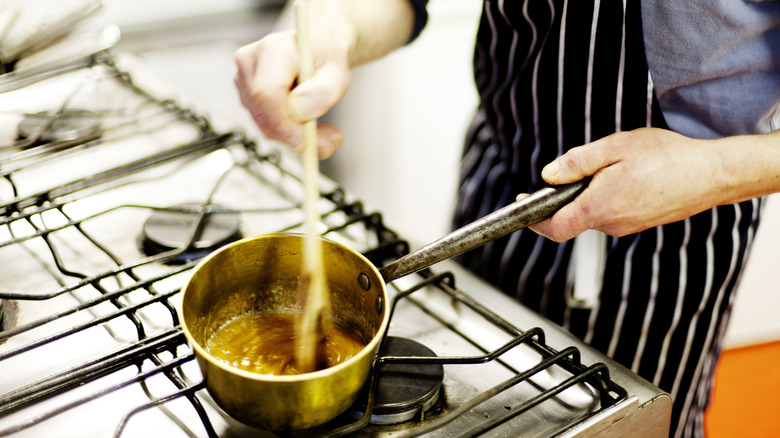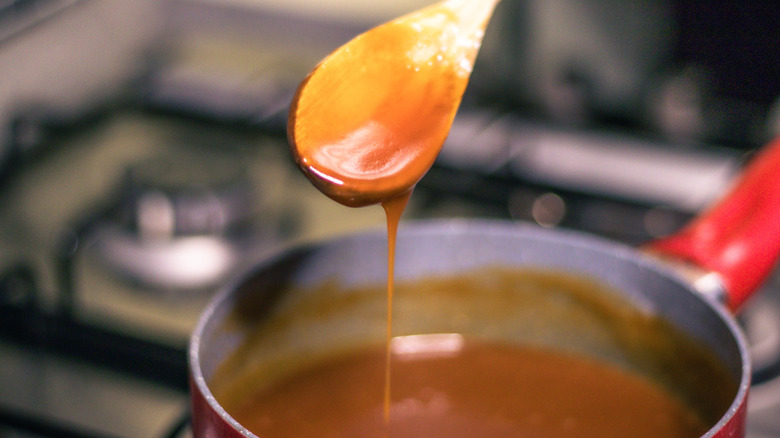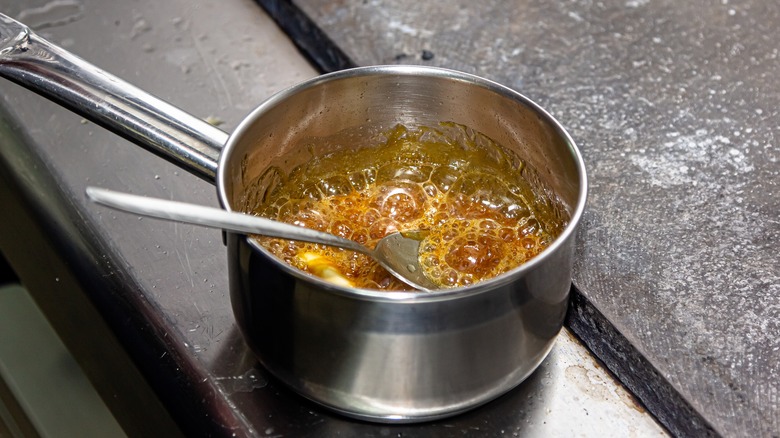The Mistake That Causes Crystallizing Caramel And How To Fix It
Heat sugar in a pot, and eventually, the white, powdery grains will melt and brown, turning into an ingredient that's associated with pure indulgence everywhere — caramel. From sweet salted caramel sauces to chewy dark chocolate-covered salted caramel candies, caramel's sweetness and rich, buttery undertones have made it a staple in kitchens everywhere. If only the actual process of making homemade caramel were as simple as it sounded, it'd have been a perfect sweetener. Alas, making a batch of perfect homemade caramel is harder than it sounds.
When making your first batch of caramel, there's a pretty good chance that you'll run into crystallization — when the smooth mixture seemingly curdles up and turns into a grainy mess that looks nothing like the caramel you're used to seeing in photos.
When you heat the sugar, it melts and turns into a semi-liquid. However, if you're not careful, the sugar will revert to its crystal form, which is how you'll find lumpy and grainy masses collecting at the top of your browned caramel. Fortunately, there are a couple of things that you can do to prevent this from happening, including stirring less and adding water to stop an early caramelization process in its tracks.
How caramel crystallizes in the pot
It's important to understand why caramel crystallizes. The root cause of caramel crystallization lies in the nature of sugar itself. When sugar is heated, it melts and begins to break down to a tasty semi-liquid form. However, sugar will take any opportunity to revert to a solid.
If the melted sugar starts to cool unevenly or even if it's agitated a bit too much, the sugar molecules will "snap" back into their solid form. With this in mind, the simplest prevention tip is to stop stirring the caramel once it has reached a boil (you can gently swirl the pan instead to keep the caramel moving). Too much agitation can cause the sugar to recrystallize!
Caramel can also crystalize if you accidentally introduce any other ingredient or impurity into the pot while the caramel is cooking. For example, even using utensils or pots that are not completely clean can also cause sugar crystals to form.
How to cure your crystalized caramel
The tricky part of making caramel is that even if a tiny bit of your caramel crystallizes, the rest of the batch may start to follow suit. This is because sugar molecules tend to attach to existing crystals more readily than forming new ones. So, even if one sugar molecule forms in the pot, if you don't fix it immediately, the rest of the liquid sugar will bond to it, which could create a chain reaction in the pot until everything's frozen solid. So, while the recipe's incredibly simple, controlling all these variables to ensure a smooth-looking batch can be a pretty hefty undertaking.
Over the years, chefs everywhere have figured out quite a few tricks to ensure that their caramel comes out just right. If the caramel is crystalizing right before your eyes, one effective method to fix it ASAP is adding a touch of water to redissolve the sugar crystal, then keep on cooking.
If you want to prevent the sugar from crystalizing, you can add an inhibitor into the mix, like corn syrup, before heating. These ingredients interfere with the sugar molecules' ability to form crystals, meaning you'll have much more leeway while working on the caramel before it crystallizes. Alternatively, you can also add a touch of acid, like lemon juice, into the mix. It will break down the sucrose crystals into invert sugar, which doesn't crystalize easily.


